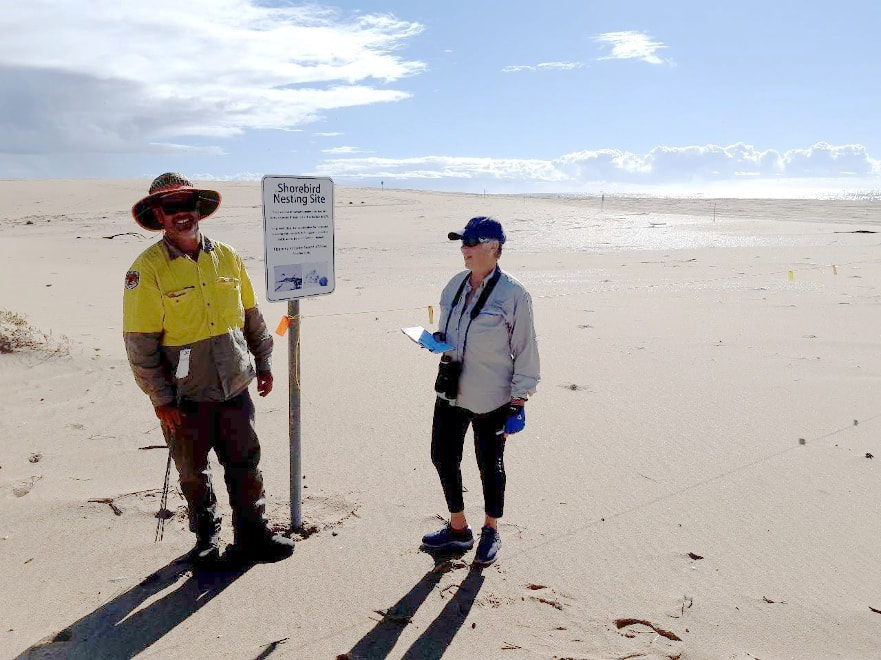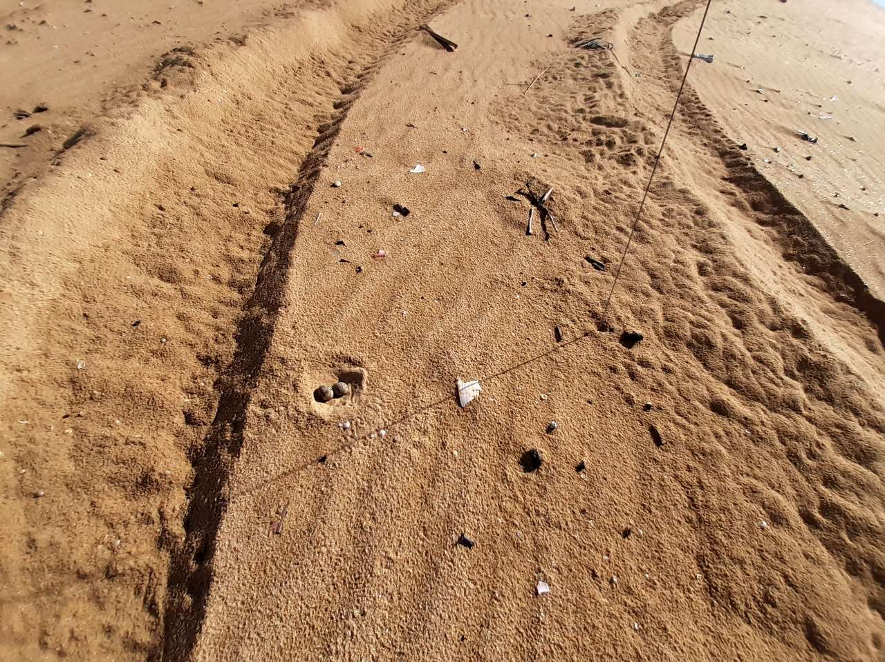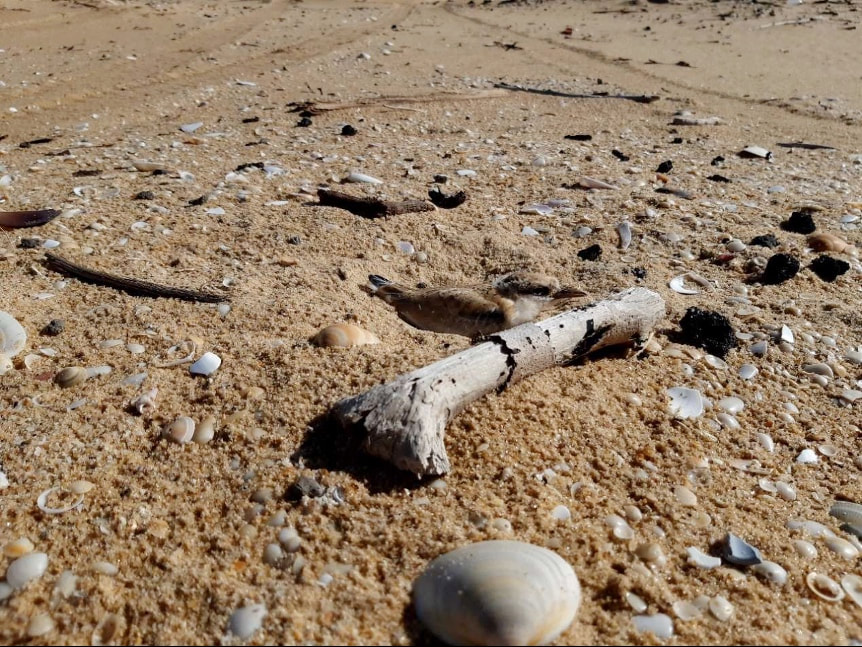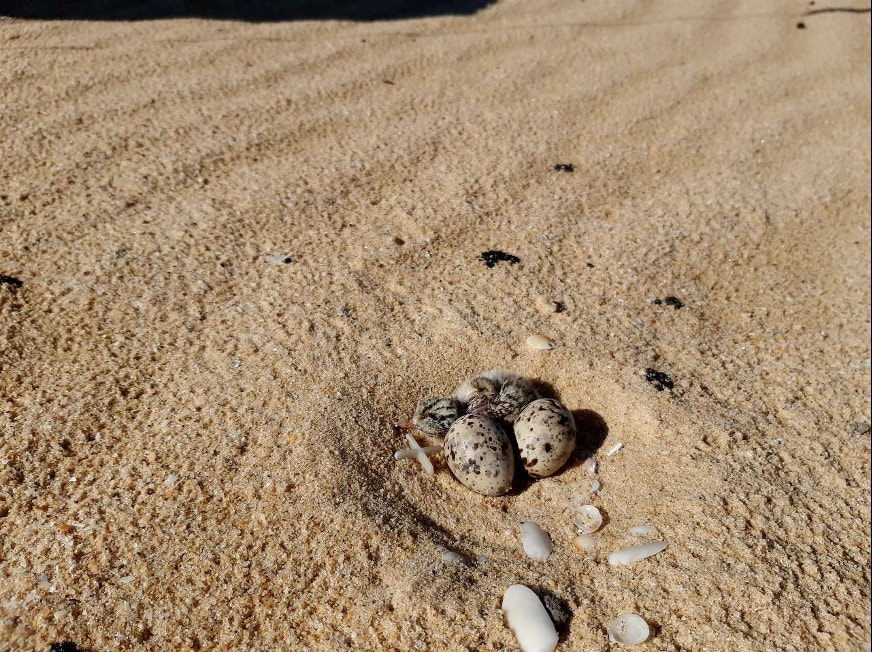Little Tern
Winda Woppa, Corrie Island & Worimi Conservation Lands
Summer 2021-22 Trisha Blair
On 28 September Sharon Taylor and myself kayaked from The Anchorage down the Myall, through the East Channel (or Short Cut) into Port Stephens and landed on Corrie Island. September is generally too early for Little Tern arrival, but resident shorebirds Pied Oystercatcher (POC) are preparing to lay for the season. Resident Beach Stone - Curlew have been breeding on the southern side of the Port, but are regularly seen along the Corrie Island shore. Migratory shorebirds, most prevalent and numerous being Eastern Curlew, Bar-tailed Godwit, Whimbrel, and Grey-tailed Tattler are arriving from the Northern Hemisphere for their non-breeding season lay-over.
We counted a pair of POC on the Mound at Winda Woppa (WW), one of which was sitting on a nest with 2 eggs (with a masked lapwing on a nest nearby). On Corrie Island there were 4 pair of POC and 1 single. There were practice scrapes, mating and defensive behaviour among the pairs. In the river there were 2 Grey-tailed Tattler. On the sand islands at the mouth of the short cut 19 Eastern Curlew and 44 Bar-tailed Godwit were counted. (Full counts in table 5)
By our next visit, almost 3 weeks later on 18 October, the migratory bird numbers had swelled. We didn’t see the WW POC, but there were 10 on Corrie and the Little Tern had arrived.
In less than four weeks nearly all the Little Tern had abandoned their nesting sites on Corrie Island, with only a handful of eggs laid. We made two more trips to Corrie to check on eggs but the few that remained were untended. The data from all trips is condensed into the tables that follow. We conclude that severe weather episodes persisting over several days, human presence and fox predation (evidenced by fixed camera shots and paw prints through the nesting sites) contributed to the LT moving elsewhere. No LT attempted nesting on the sand mound on WW this year. Thanks to Ann Woods for her observations of shorebirds in this location.
In December we discovered from Kath Howard – Threatened Species Officer with NPWS, that Little Tern had been observed on the Worimi Conservation Lands (WCL) midway along Stockton Beach. Keen to find out where the initial influx of LT on Corrie Island had gone, we became involved in the monitoring of this colony. I joined the first systematic monitoring of the area on 22 December with Brad Nesbitt – Field Researcher contracted to NSW NPWS.
We were transported to the remote site midway along Stockton beach by WCL Officers Jamie Tarrant, Stacey Freeman and Karly Greentree. They were very keen to participate in the monitoring of breeding LT. One or more of the team very kindly accompanied us and assisted on our subsequent trips until 25 January.
Table 1 – Little Tern on Corrie Island (BP = breeding plumage)
Date |
18/10 |
25/10 |
1/11 |
8/11 |
16/11 |
2311 |
29/11 |
Adults in BP |
16 |
13+ |
46 |
49 |
1 |
3 |
1 |
Nests |
Nil |
Nil |
2 |
5 |
3 |
1 |
1 |
Eggs |
Nil |
Nil |
5 |
8 |
5 |
2 |
2 |
Chicks |
Nil |
Nil |
Nil |
Nil |
Nil |
Nil |
Nil |
Table 2 – Little Tern on Worimi Conservation Lands
Table 2 – Little Tern on Worimi Conservation Lands
Date |
22/12 |
30/12 |
7/1 |
12/1 |
19/1 |
25/1 |
4/2 |
Adults in BP |
40 |
45+ |
26 |
36 |
8 |
8 |
Nil |
Nest |
20 |
28 |
16 |
14 |
6 |
Nil |
Nil |
Eggs |
40 |
30 |
27 |
22 |
10 |
Nil |
Nil |
chicks |
2 |
1 |
1 |
2 |
Nil |
Nil |
Nil |
Runners |
Nil |
11 |
4+ |
2 |
7 |
Nil |
Nil |
Fledglings |
Nil |
Nil |
Nil |
5 |
4 |
5 |
Nil |
The breeding success of a colony is measured by the number of successful fledglings from the total number of breeding adult pairs. With approximately 40 breeding pair observed, a 50% success rate, or 20 fledglings would be required to result in a stable population.
With the failure on Corrie and the very low number of fledglings from WCL, this breeding season is considered unsuccessful for LT in these two locations.
Contributing factors to this result were
Breeding data for Pied Oystercatchers
Table 3 - Pied Oystercatcher; Winda Woppa sand mound
With the failure on Corrie and the very low number of fledglings from WCL, this breeding season is considered unsuccessful for LT in these two locations.
Contributing factors to this result were
- · Intense rain periods
- · Strong winds lasting several days
- · Fox predation
- · Human presence and disturbance from 4wds
Breeding data for Pied Oystercatchers
Table 3 - Pied Oystercatcher; Winda Woppa sand mound
Date |
9/9 |
28/9 |
3/10 |
6/10 |
25/10 |
6/11 |
Adults |
2 |
2 |
2 |
2 |
2 |
2 |
Nests |
1 |
1 |
1 |
Nil |
Nil |
Nil |
Eggs |
2 |
2 |
1 |
Nil |
0 |
Nil |
Chicks |
Nil |
Nil |
Nil |
1 |
1 |
Nil |
Fledglings |
Nil |
Nil |
Nil |
Nil |
Nil |
1 |
The pair that nest each year within the mound area successfully raised one chick again.
Table 4 – POC; Corrie Island breeding
Table 4 – POC; Corrie Island breeding
Date |
28/9 |
18/10 |
25/10 |
1/11 |
8/11 |
16/11 |
23/11 |
29/11 |
Adults |
9 |
10 |
8 |
4 |
6 |
6 |
8 |
7 |
Nests |
3 practice |
5 practice |
1 |
2 |
2 |
2 |
Nil |
Nil |
Eggs |
Nil |
Nil |
2 |
2/2 |
2/0 |
Nil |
Nil |
Nil |
Chicks |
Nil |
Nil |
Nil |
Nil |
Nil |
Nil |
Nil |
Nil |
The fate of eggs/chicks from the nest discovered on 25 October is inconclusive as the timing of their disappearance by 16 Nov could mean they, or at least one, hatched and was kept hidden from us on subsequent visits. Cam footage of a fox with small prey in its mouth on 30 November could suggest that a chick was hatched but was predated at 2 weeks old.
The fate of the eggs discovered on 1 Nov was almost certainly a fox due to tracks noted before and after the event.
Shorebird counts.
This table contains total numbers of resident POC, Beach Stone-Curlew and migratory birds as described. They were observed in the river, the port and on or near Corrie Island during our regular visits.
Table 5 – Resident and migratory shorebird counts
The fate of the eggs discovered on 1 Nov was almost certainly a fox due to tracks noted before and after the event.
Shorebird counts.
This table contains total numbers of resident POC, Beach Stone-Curlew and migratory birds as described. They were observed in the river, the port and on or near Corrie Island during our regular visits.
Table 5 – Resident and migratory shorebird counts
Date |
28/9 |
18/10 |
25/10 |
1/11 |
8/11 |
23/11 |
29/11 |
10/1 |
POC |
11 |
13 |
11 |
11 |
6 |
9 |
9 |
9 |
Beach Stone Curlew |
Nil |
2 |
Nil |
1 |
Nil |
Nil |
Nil |
Nil |
Eastern Curlew |
19 |
48 |
9 |
34 |
21 |
44 |
11 |
11 |
Bar-tailed Godwit |
44 |
109 |
59 |
186 |
29 |
122 |
19 |
31 |
Grey-tailed Tattler |
2 |
1 |
2 |
5 |
Nil |
Nil |
3 |
Nil |
Whimbrel |
Nil |
Nil |
10 |
21 |
15 |
Nil |
6 |
Nil |
Note: Local tide conditions and prevailing weather conditions affect feeding and roosting cycles. These factors are likely reflected in the variance in numbers of birds observed on different dates, not necessarily that birds are present of absent in the greater marine area
Purpose
The data gathered systematically in monitoring trips is contributing to ongoing research and management of Little Tern and Shorebirds. The Little Tern and POC data is entered into NSW NPWS beach nesting spreadsheets and then uploaded into Bionet by Paul Mahon at the conclusion of each season. Neil Fraser updates all of Sharon’s bird counts (LT, Shorebirds AND all other bird species encountered) into Birdlife Australia’s Bird Data.
We are also assisting Newcastle University PhD research into E Curlew distribution in port Stephens by sharing our data and observations as requested.
Acknowledgements
Thanks to Ann Woods for her data and photo input at Winda Woppa; Kath Howard from Threatened Species Program NSW NPWS for her work and support and for coordinating with other govt departments and agencies; NPWS field research contractor Brad Nesbitt and Paul Mahon NPWS who created and manages the beach nesting bird data on google drive for all of NSW; Worimi Chair Jamie Tarrant along with Visitor Services Officer Karly Greentree and Project Officer Stacey Freeman for enabling the WCL LT monitoring; Nick Coleman MCC and Silas Darnell, NPWS contractor Manning River, for on the ground and moral support; Neil Fraser as a source of knowledge, encouragement and data upload. MKEG executive members for their input and support.
Finally, a big thanks to Sharon Taylor for her expert contributions to this document. Most importantly for being a vital part of our team of two on our field trips and for producing extensive bird counts and supporting photography in all three locations.
Purpose
The data gathered systematically in monitoring trips is contributing to ongoing research and management of Little Tern and Shorebirds. The Little Tern and POC data is entered into NSW NPWS beach nesting spreadsheets and then uploaded into Bionet by Paul Mahon at the conclusion of each season. Neil Fraser updates all of Sharon’s bird counts (LT, Shorebirds AND all other bird species encountered) into Birdlife Australia’s Bird Data.
We are also assisting Newcastle University PhD research into E Curlew distribution in port Stephens by sharing our data and observations as requested.
Acknowledgements
Thanks to Ann Woods for her data and photo input at Winda Woppa; Kath Howard from Threatened Species Program NSW NPWS for her work and support and for coordinating with other govt departments and agencies; NPWS field research contractor Brad Nesbitt and Paul Mahon NPWS who created and manages the beach nesting bird data on google drive for all of NSW; Worimi Chair Jamie Tarrant along with Visitor Services Officer Karly Greentree and Project Officer Stacey Freeman for enabling the WCL LT monitoring; Nick Coleman MCC and Silas Darnell, NPWS contractor Manning River, for on the ground and moral support; Neil Fraser as a source of knowledge, encouragement and data upload. MKEG executive members for their input and support.
Finally, a big thanks to Sharon Taylor for her expert contributions to this document. Most importantly for being a vital part of our team of two on our field trips and for producing extensive bird counts and supporting photography in all three locations.
Photos by Kath Howard





